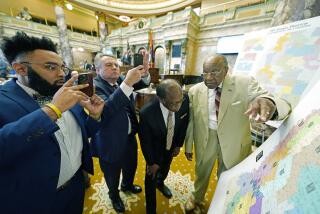High Court Rejects Voter Districts Drawn Only on Basis of Race
WASHINGTON — The Supreme Court, its conservative majority in charge, dealt a severe blow Thursday to the political power wielded by blacks and Latinos, ruling that the government may not use race as a primary reason for drawing election district boundaries.
The 5-4 ruling in a Georgia case threatens many, if not all, of the districts drawn in the last decade for the purpose of electing more minority representatives to Congress, state legislatures and county boards. It highlighted the final day of a term in which the conservative court moved dramatically to curtail the use of race in a way that benefits minorities.
In other rulings Thursday, the high court:
* Gave Christian activists two victories, ruling that the government may not deny funding or free-speech protection to any group because its message is explicitly religious.
In a 5-4 ruling, the court said the University of Virginia must subsidize a magazine run by Christian students on the same basis as other student publications, while by a 7-2 vote it said that Ohio state officials were wrong to bar the Ku Klux Klan from erecting a cross in a park near the Capitol.
* Upheld a broad federal regulation that allows officials to block development on land where endangered animals live. The 6-3 ruling turned back a challenge from the timber industry, which maintained that the Endangered Species Act of 1973 as originally written did not cover private property.
Like the ruling two weeks ago undercutting federal affirmative action programs, the justices insisted Thursday that the Constitution requires the government to “cleanse” itself of using race as a basis for making decisions, whether it is putting persons on juries, awarding government contracts or drawing electoral boundaries.
The Voting Rights Act of 1965 seeks to give all Americans “an equal opportunity to gain public office regardless of race,” wrote Justice Anthony M. Kennedy for the court. “That end is neither assured nor well served, however, by carving electorates into racial blocs,” he said.
President Clinton said that he was “disappointed” in the court’s ruling on voting rights and called it “a setback in the struggle to ensure that all Americans participate fully in the electoral process.”
Unquestionably, the strict ban on the use of race as a basis for drawing election boundaries marks a decided change in the law and one that is likely to work to the disadvantage of minorities. For the last 15 years, the Justice Department has used the Voting Rights Act to press states, counties and cities to do their best to create districts that will elect black and Latino candidates.
Until 1990, not a single African American was elected to Congress during this century from Alabama, Florida, North Carolina, South Carolina, Louisiana or Virginia, all states with substantial black populations.
But after the 1990 census, the states redrew their electoral boundaries, and the number of black representatives in Congress doubled to 39. All but three of those representatives come from districts with black majorities, however.
Now, under Thursday’s ruling, white voters can file lawsuits to challenge those race-based districts as unconstitutional.
In one sense, the change in direction on voting rights comes as no surprise.
Two years ago, the court, by the same 5-4 vote, revived a white voter’s challenge to a snake-like district in North Carolina and said that extreme “racial gerrymandering” may be unconstitutional.
That ruling, in Shaw vs. Reno, set off a backlash across the South. Lawsuits were filed challenging majority-black districts in most states, and federal judges declared unconstitutional the congressional boundaries in Georgia, Louisiana and Texas.
But it was unclear whether the court meant to outlaw only “bizarre”-looking districts or all those that were drawn mainly for racial reasons.
Intent at Issue
On Thursday, Kennedy said that what counts is the intent of the legislature, not the shape of the district.
White voters who challenge a “race-based” district are not “required to make a threshold showing of bizarreness,” he said. If race was the “predominant factor” in drawing a district’s lines, he said, it violates the equal-protection clause of the Constitution.
“Just as the state may not segregate citizens on the basis of race in its public parks, buses, golf courses, beaches and schools,” he wrote, “it may not separate its citizens into different voting districts on the basis of race.”
Before Thursday, most state lawmakers justified their creation of “majority-minority” districts on the grounds that federal civil rights officials had pressed them to do just that. But Kennedy said that federal officials cannot go that far.
“When the Justice Department . . . compels race-based districting, it by definition raises a serious constitutional question and should not receive deference,” he wrote.
His opinion in the case (Miller vs. Johnson, 94-631), was signed by Chief Justice William H. Rehnquist and Justices Sandra Day O’Connor, Antonin Scalia and Clarence Thomas.
Experts in voting rights law said that the ruling will surely spur more lawsuits and that it calls into question the congressional seats held by most black and Latino representatives.
“I would say a majority of them are in danger,” said American University law professor Jamin Raskin. The least vulnerable districts, however, are those in regions where black voters are concentrated in a specific geographic area, such as in Atlanta, New Orleans, Chicago, Los Angeles or other major cities, he said.
Georgia District
The ruling specifically struck down a predominantly black congressional district in Georgia that stretches from Savannah to Atlanta and is served by Democratic Rep. Cynthia McKinney, one of three African American lawmakers from that state. Now Georgia lawmakers will have to redraw the district’s boundaries, putting McKinney’s seat in jeopardy.
Civil rights lawyers who have fought for greater representation for minorities called the ruling “one of the most disturbing opinions in recent memory.”
“The Supreme Court seems determined to dismantle the structure of civil rights in this country,” said Laughlin McDonald, director of the American Civil Liberties Union’s Voting Rights Project in Atlanta. “The result could be a return to the days of all-white government.”
But Assistant Atty. Gen. Deval Patrick, the Clinton Administration’s civil rights chief, sounded a more upbeat note: “It is a setback, but it is not the end of the road. We will continue to defend the plans in Louisiana and elsewhere.”
He noted two encouraging signs. Justice O’Connor attached a brief concurring opinion saying that the court was attacking only the “extreme instances of gerrymandering.”
Among the justices, O’Connor is noted for sitting on the fence. Often she writes opinions that, as Raskin said, “put a foot in both camps.” As usual, lower-court judges will have to puzzle out what she meant by “extreme.”
California Ruling
Patrick also said that he “takes comfort” from the court’s one-line order Thursday upholding California’s boundaries for its 52 members of Congress.
Last year, a three-judge panel said that the 1992 redistricting plan followed “traditional principles” and did not show evidence of “racial gerrymandering.” Without writing an opinion, the court upheld that conclusion in DeWitt vs. Wilson, 94-275.
California Democratic Party spokesman Bob Mulholland said the court’s decision to accept California’s plan while rejecting Georgia’s reflects the fact that California achieved greater minority opportunities without tortuous abuse of district lines.
“The Georgia case made it quite obvious that the court will not stand for those districts,” Mulholland said. “Californians, whether Republicans or Democrats, have always drawn lines that withstood court scrutiny.”
Christine Berman, a spokeswoman for Gov. Pete Wilson, said in Sacramento that the governor was “pleased by the Supreme Court’s decision.”
Alan Heslop of Claremont McKenna College, one of the state’s leading demographics experts, said the court’s decision affirms the fact that while California avoided “the extraordinary contortions that raised gerrymander charges in other states, they do indeed concentrate minority registrations and ensure greater electoral opportunities.”
But the high court summary ruling will not foreclose further lawsuits in California that challenge districts established for county supervisors or school board members.
Landmark Case
Longtime critics of racial gerrymandering hailed the Georgia ruling as a landmark.
“The court took an important step toward treating American voters not as black or white but simply as Americans,” said Abigail Thernstrom, a voting-rights expert at Boston University. “No longer can voters be herded into separate districts solely on the basis of skin color.”
While the ruling dealt with the use of race in congressional districts, it set constitutional standards that would also apply to districts created especially to elect Latinos to state and local offices, as well as to Congress.
In a strong dissent, which she read from the bench, Justice Ruth Bader Ginsburg accused the majority of ignoring the history of “rank discrimination against African Americans.” She noted that “legislative districting is a highly political business,” with many competing interests, that should be left to politicians.
She concluded by saying that the ruling in the Georgia case is not the last word on the issue. A few hours later, her prediction proved accurate as the justices announced that they would hear appeals this fall on the fate of black-majority districts in North Carolina and Texas.
(BEGIN TEXT OF INFOBOX / INFOGRAPHIC)
Final Flurry of Rulings
Wrapping up its current term, the Supreme Court on Thursday:
Issue: Redistricting
What Court Decided: Struck down a Georgia congressional redistricting plan, making it harder for states to take race into account when drawing election districts to comply with the Voting Rights Act.
Vote: 5-4
What Court Decided: Ruled that four residents who challenged Louisiana’s congressional reapportionment plan lacked the legal standing to sue.
Vote: 9-0
Issue: Environment
What Court Decided: Ruled that government regulators can ban destruction of the natural homes of endangered or threatened species on private property. The justices ruled landowners violate the Endangered Species Act if they change these wildlife habitats and that even unintentional harm is illegal.
Vote: 6-3
Issue: Free speech
What Court Decided: Decided that a public university wrongly refused to subsidize a student-run Christian magazine. The justices said the University of Virginia misunderstood the constitutionally required separation of church and state and violated the free-speech rights of the Christian students.
Vote: 5-4
Issue: Ku Klux Klan
What Court Decided: Ruled that the state of Ohio erred in barring the Ku Klux Klan from displaying a Christian cross in a public park adjacent to the state Capitol in Columbus during the 1993 Christmas season.
Vote: 7-2
Source: Times staff and wire reports
More to Read
Sign up for Essential California
The most important California stories and recommendations in your inbox every morning.
You may occasionally receive promotional content from the Los Angeles Times.











